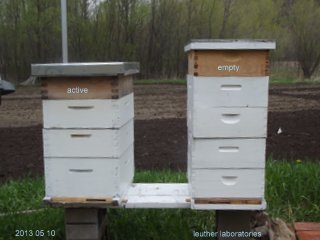The bees had not produced much honey when we checked probably because of rain almost every day so I did not examine the hives carefully. If I had, I may have seen evidence of this unanticipated swarm. When the weather improved they were busy foraging. Raspberries and honey locust were always full of bees. They seem to totally ignore most other blossoms including the abundant "daisy flea bane" that attracts a tiny iridescent hovering bee.
This large swarm in a walnut tree was first noticed in the late morning. Empty hives were arranged near the tree that they totally ignored.
The hive left in less than an hour after we noticed it.
By the time we suited up, they were totally gone.





















